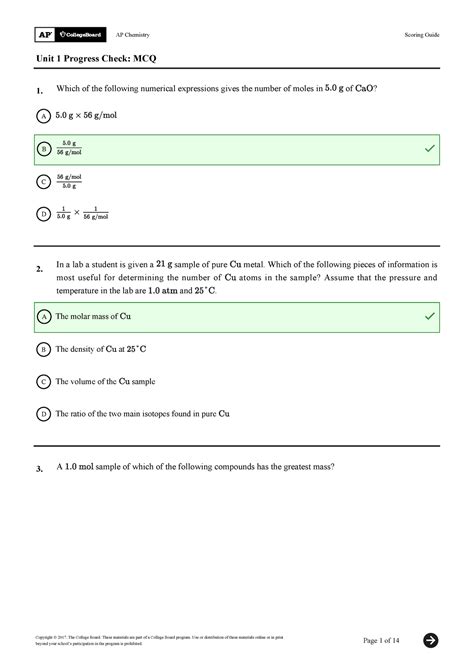Master the challenging concepts of AP Chemistry Unit 1 with these rigorous multiple-choice questions. Test your understanding and prepare for exam success.

Unit 1: Matter and Its Interactions
Matter and Measurement
1. Which of the following measurements has the largest uncertainty?
(A) 25.00 mL
(B) 25.0 mL
(C) 25 mL
(D) 2 × 10^2 mL
2. A solution has a density of 1.25 g/mL. What is the mass of 500 mL of this solution?
(A) 500 g
(B) 625 g
(C) 1250 g
(D) 2500 g
Stoichiometry
3. In the reaction 2H2O → 2H2 + O2, how many moles of H2O are needed to produce 0.5 mole of H2?
(A) 0.25
(B) 0.5
(C) 1
(D) 2
4. A reaction between 2.0 moles of NaOH and 2.0 moles of HCl produces salt and water. Which reactant is limiting?
(A) NaOH
(B) HCl
(C) salt
(D) water
Atomic Structure and Properties
5. Which of the following is NOT a fundamental particle of an atom?
(A) Proton
(B) Neutron
(C) Electron
(D) Quark
6. The atomic number of an element represents the number of:
(A) protons
(B) neutrons
(C) electrons
(D) orbitals
7. Which of the following elements has the highest first ionization energy?
(A) Li
(B) C
(C) N
(D) O
Periodic Properties
8. The atomic radius generally:
(A) increases down a group
(B) decreases down a group
(C) increases across a period
(D) decreases across a period
9. Which of the following elements is most electronegative?
(A) F
(B) Cl
(C) Br
(D) I
10. The noble gases are characterized by:
(A) high reactivity
(B) high ionization energy
(C) low electronegativity
(D) all of the above
Chemical Reactions
11. A reaction is exothermic if:
(A) heat is released
(B) heat is absorbed
(C) the reactants are in lower energy states than the products
(D) the reactants have more potential energy than the products
12. Which of the following is NOT a factor that affects the rate of a chemical reaction?
(A) temperature
(B) concentration
(C) catalyst
(D) activation energy
Solutions
13. A 1.0 M solution of NaCl contains:
(A) 1 mole of NaCl per liter of solution
(B) 58.44 g of NaCl per liter of solution
(C) 1 mol of NaCl per kg of water
(D) 58.44 g of NaCl per kg of water
14. Which of the following is a colligative property?
(A) boiling point elevation
(B) solubility
(C) density
(D) molarity
15. A solution with a pH of 7 is:
(A) acidic
(B) basic
(C) neutral
(D) concentrated
Acids, Bases, and Salts
16. The pH of a 0.1 M solution of HCl is:
(A) 1
(B) 2
(C) 7
(D) 14
17. Which of the following salts is soluble in water?
(A) CaCO3
(B) PbCl2
(C) BaSO4
(D) AgCl
18. A buffer solution:
(A) resists changes in pH
(B) is made up of an acidic and basic component
(C) has a pH of 0 or 14
(D) has a constant pOH
19. Which of the following ions is a spectator ion in the reaction of NaOH and HCl?
(A) Na+
(B) OH-
(C) H+
(D) Cl-
20. A titration is used to:
